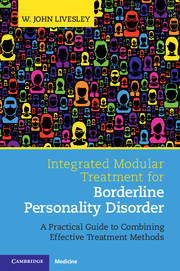 Integrated Modular Treatment for Borderline Personality Disorder
Integrated Modular Treatment for Borderline Personality Disorder Book contents
- Frontmatter
- Dedication
- Contents
- Preface
- Section 1 Introduction and Framework for Understanding Borderline Personality Disorder
- Section 2 Assessment and Treatment Planning
- Section 3 General Treatment Modules
- Section 4 Safety, Containment, and Engagement: The Initial Phase of Treatment
- Section 5 Improving Emotional Regulation and Modulation
- Section 6 Exploration and Change: Treating Interpersonal Problems
- Introduction
- 18 Principles for Treating Maladaptive Schemas and Interpersonal Patterns
- 19 Treating Submissiveness
- 20 Working with the Core Interpersonal Conflict
- Section 7 Constructing an Adaptive Sense of Self
- Section 8 Retrospect and Prospect
- References
- Index
Introduction
from Section 6 - Exploration and Change: Treating Interpersonal Problems
Published online by Cambridge University Press: 16 February 2017
- Frontmatter
- Dedication
- Contents
- Preface
- Section 1 Introduction and Framework for Understanding Borderline Personality Disorder
- Section 2 Assessment and Treatment Planning
- Section 3 General Treatment Modules
- Section 4 Safety, Containment, and Engagement: The Initial Phase of Treatment
- Section 5 Improving Emotional Regulation and Modulation
- Section 6 Exploration and Change: Treating Interpersonal Problems
- Introduction
- 18 Principles for Treating Maladaptive Schemas and Interpersonal Patterns
- 19 Treating Submissiveness
- 20 Working with the Core Interpersonal Conflict
- Section 7 Constructing an Adaptive Sense of Self
- Section 8 Retrospect and Prospect
- References
- Index
Summary
Introduction
With improved emotion regulation, treatment gradually shifts to treating interpersonal problems, becoming more complex in the process. The previous focus on the single impairment of emotional dysregulation now broadens to cover the multiple interpersonal problems that characterize borderline personality disorder (BPD). Treatment also becomes less structured in order to deal with the broader array of problems covered in most sessions. Although the use of generic interventions, cognitive-behavioural methods, and narrative construction continues, interpersonal and psychodynamic strategies and methods are added to the mix.
The scenarios patients present in the latter part of treatment tend to differ from earlier ones. They are less concerned with crises and unstable emotions and more with interpersonal problems. They are also handled differently. The interpersonal component is explored in more detail to identify and change maladaptive interpersonal schemas and interpersonal behaviour.
This phase of treatment makes more demands of the therapist than previous phases because it is less structured and much “messier.” Previously, it was possible to focus on specific problems using well-defined interventions. The challenge for therapists was to manage intense emotions and suicidality, not what strategies and interventions to use – in many situations this was rather obvious. In contrast, interpersonal problems are complex and they interact in complex ways. This means that treatment becomes less predictable because the issues and scenarios patients present vary considerably across sessions. These challenges are addressed in two ways. First, a general framework is proposed for changing the maladaptive schemas, ways of thinking, and interpersonal problems that characterize individual patients, which is discussed in the next chapter. Second, this general framework is used to treat submissive behaviour (Chapter 19) and intense dependency needs and the core conflict of neediness versus fear of rejection (Chapter 20).
- Type
- Chapter
- Information
- Integrated Modular Treatment for Borderline Personality DisorderA Practical Guide to Combining Effective Treatment Methods, pp. 189 - 190Publisher: Cambridge University PressPrint publication year: 2017


